This is not only the best Picasso show that I’ve seen in a long time, but it’s probably the best selection of Ben Nicholson paintings that I’ve ever seen together. I was really, seriously pleasantly surprised as not only are there loads of Picasso’s that you would normally only see in Paris, New York and Spain but there’s also a load of stunning modern British paintings that I’d never seen - and I’ve hunted down and seen a lot.
As soon as I entered the exhibition I got a really good feeling as I could see some tasty Picasso’s that I hadn’t seen before - and in actual fact I hadn’t even got to the really good rooms yet.
Take Picasso’s Bottle and Books 1910-11, in the first room. This is a stunning cubist painting where at one moment it looks as if you’re surveying the landscape of a town, and the next the bottle and the books the title implies - a perfect almost intangible cubist juxtaposition. Then look at Head of a Man, 1912 right beside it, another cubist classic with cool, almost graffiti like words painted on that make the work look contemporary. Not only that, but there’s pencil scribbled on it and the whole thing looks roughly thrown together, but like great pieces of art something magical has fallen together out of that chaos.

Pablo Picasso
Bottle and Books 1910-11
Private Collection
© Succession Picasso / DACS 2011
Titled Picasso and Modern British Art the idea of the show is to explore Picasso’s legacy and influence on British Art, examining the impact on artists like David Hockney, Francis Bacon and Ben Nicholson, to name just a few. What I didn’t expect was the exhibition would dig up some real treasures of British Art.
For instance look at Duncan Grant’s Interior at Gordon Square 1914-15. This stunning paper collage makes me want to get back in the studio and start sticking pieces of paper together right now. What makes the work so good is the way all the different brush marks on the paper that has been cut up and stuck down are visible. It sets up a real rhythm that works refreshingly in contrast to the sane and calm way Grant has recreated a room interior with the paper. It looks a bit like a Ben Nicholson but the flatness is usurped by the choppy and chopped brushstrokes. An amazing picture.
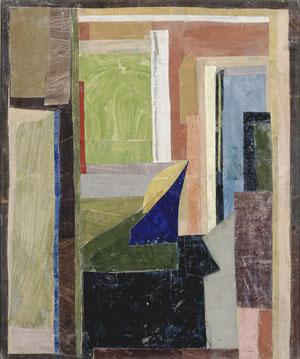
Duncan Grant
Interior at Gordon Square 1914–15
Private collection
© Estate of Duncan Grant. All rights reserved, DACS 2011
And the next room went on with more pictures I didn’t expect - small painted costume ideas that Picasso made for the Russian Ballet (these came from the Royal Opera House intriguingly). As you'd expect these are all full of classic Picasso inventiveness and there are also two of his stand out ‘Ingres’ type drawings - Portrait of Lydia Lopokova 1919 and Portrait of Vladamir Polunin 1919 - all simple pencil lines creating magical and fully formed three dimensional people.

Pablo Picasso
Portrait of Vladimir Polunin
Private Collection
© Succession Picasso / DACS 2011
But it was the next room that really blew me away - a just totally stunning room of really great Ben Nicholson’s such as 1933 (coin and musical instruments), 1933. The white lines gouged into the board the picture is made on dance and roll down the front of your eyes like a mad jazz record loosely based on a still life. It’s a perfect juxtaposition of music and still life - two possibly opposing things slammed together so beautifully and sensitively to make something new, real painting wonder.
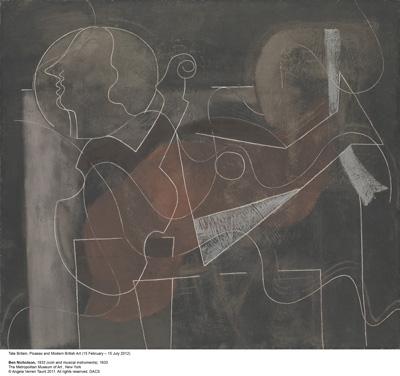
Ben Nicholson
1933 (coin and musical instruments), 1933
The Metropolitan Museum of Art , New York
© Angela Verren Taunt 2011. All rights reserved, DACS
Also look at 1933 (musical instruments) 1932-3, it’s such a bold and confident painting. You can see where Nicholson carved into the board and changed his mind and then painted over the gouges - the result is a glorious trail of scratches that criss cross parts of the paintings. It’s like being able to see the working in a maths equation - and not only that but the painting has some superb Braque like colours.

Ben Nicholson
1933 (musical instruments) 1932– 3
Kettle’s Yard, University of Cambridge
© Angela Verren Taunt 2011. All rights reserved, DACS
And these paintings show just what a great colourist Ben Nicholson was - take a painting like 1924 (Painting - Trout) 1924. There’s gorgeous close in tone blues, greens, yellows and greys - with just a few trademark Ben Nicholson lines in the top left corner.

Ben Nicholson
1924 (painting – trout) 1924
Private collection
© Angela Verren Taunt 2011. All rights reserved, DACS
Then the next room knocks your breath away again - it’s literally packed with Picasso’s and at the far end it has two stand out large ones. On the right is Reading at a Table, 1935 which has been lent from the Metropolitan Museum of Art. It’s a classic that mixes dark and light sections, a gorgeous still life of a plant, and like all the best Picasso’s there’s that brilliant combo of ancient Greek lyricism - with the flowers around the girl’s hair - and somehow also a sense of modernity. And on the left is Nude Green Leaves and Bust (also know as bust nude with sculptors turntable). It's a great meditation on art and reality with the sculpted head and the nude model contrasted like many of Picasso’s pieces in his Vollard Suite.
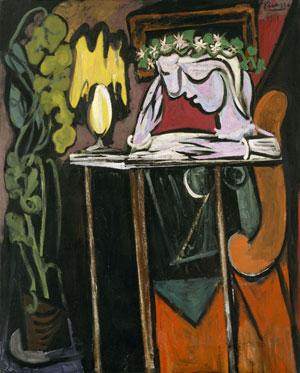
Pablo Picasso
Reading at a Table 1934
Lent by the Metropolitan Museum of Art, Bequest of Florene M. Schoenborn, in honor of William S. Lieberman, 1995
© Succession Picasso / DACS 2011
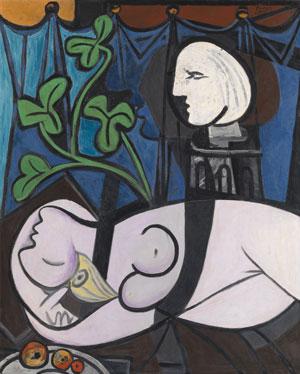
Pablo Picasso
Nude, Green leaves and Bust (also known as Bust Nude with Sculptor’s Turntable) 1932
Tate. Lent from a private collection 2011
© Succession Picasso / DACS 2011
And the exhibition goes on with more great stuff - some bits work brilliantly like the room comparing Picasso’s The Source, 1921 with Henry Moore’s Reclining Figure 1936. It’s a really good match that makes each piece of art look even better. The comparison brings out the rounded body fullness of form that both pieces have and makes the Moore look much more feeling than I had thought before - much warmer and more sensitive. It also shows how cleverly Picasso has put sophisticated abstract 3D ideas into what appears a seemingly simple and lyrical painting.
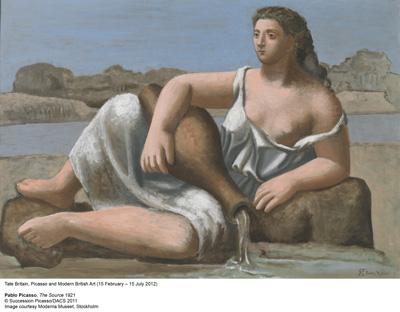
Pablo Picasso
The Source 1921
© Succession Picasso/DACS 2011
Image courtesy Moderna Museet, Stockholm

Henry Moore
Reclining Figure 1936
The Hepworth Wakefield
Reproduced by permission of The Henry Moore Foundation
Some bits of the exhibition were not necessarily quite so brilliant - I wasn’t so convinced by the relationship that was being set up between Picasso and Bacon, or Graham Sutherland and Picasso - but you’ve got to admit that there’s a great selection of paintings by both of the British artists concerned.
It’s also a shame that there aren’t any of David Hockney’s really great line drawing portraits to compare with Picasso’s - but then there are a couple of his superb photomontages that take Picasso’s cubism a stage further in a masterful and imaginative way.
It’s a stunning exhibition - don’t miss it.
Review by Robert Dunt, practising artist and Founder & CEO ArtTop10.com - www.robertdunt.com
Picasso and Modern British Art is at Tate Britain and runs until 15 July 2012.